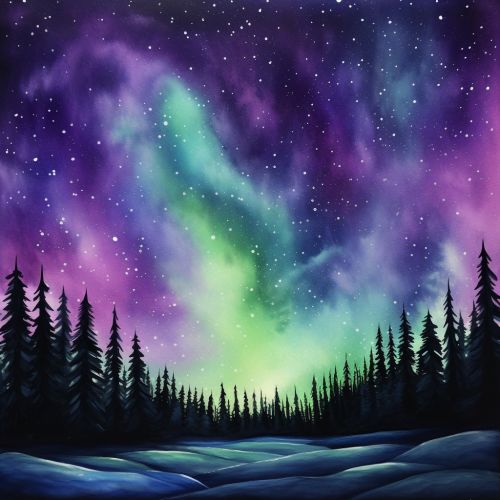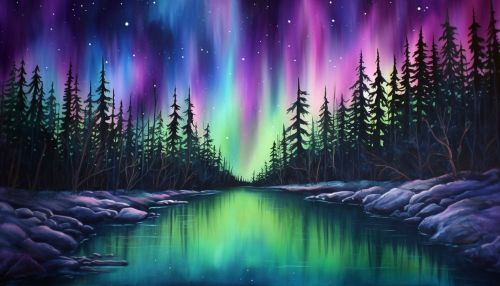Aurora (astronomy)
Introduction
The aurora is a natural light display that occurs in the sky, predominantly in the high-latitude regions around the Arctic and Antarctic. The phenomenon is caused by the collision of solar wind and magnetospheric charged particles with the high altitude atmosphere (thermosphere). The resulting ionization and excitation of atmospheric constituents emit light of varying color and complexity. The form of the aurora, occurring within bands around both polar regions, is also dependent on the amount of acceleration imparted to the precipitating particles.
Etymology
The term "aurora" is derived from the name of the Roman goddess of the dawn, Aurora. The scientific term "aurora" is coined from the Latin word 'aurora' meaning "sunrise" or the "dawn." The name was historically used to refer to the early morning light observed in the polar regions, which resembled the break of dawn.
Occurrence
Auroras occur predominantly in the polar regions, within a radius of approximately 2500 km from the magnetic pole. They are a result of the interaction between the solar wind, a stream of charged particles escaping the Sun, and the Earth's magnetic field. This interaction causes the emission of light from atoms in the Earth's atmosphere, creating the brilliant displays we see as auroras.
Types of Aurora
There are two types of auroras - Aurora Borealis (or the Northern Lights) and Aurora Australis (or the Southern Lights). The Aurora Borealis is visible from the northern hemisphere, while the Aurora Australis is visible from the southern hemisphere.
Formation
The formation of an aurora begins with the emission of charged particles from the Sun, a phenomenon known as a solar wind. These particles travel towards the Earth, where they interact with the Earth's magnetic field. The charged particles are guided by the magnetic field towards the poles, where they collide with atoms and molecules in the Earth's atmosphere, causing them to become excited. As the atoms and molecules return to their normal state, they emit light, creating the aurora.


Colors of Aurora
The colors of an aurora are a result of the type of gas particles that are colliding. The most common auroral color, a pale yellowish-green, is produced by oxygen molecules located about 60 miles above Earth. Rare, all-red auroras are produced by high-altitude oxygen, at heights of up to 200 miles. Nitrogen produces blue or purplish-red aurora.
Viewing Auroras
The best places to watch the auroras are usually in the magnetically polar regions of the northern and southern hemispheres. These areas are known as the 'auroral oval'. In the northern hemisphere, this includes parts of Canada, Greenland, Iceland, Norway, Sweden, Finland and Russia. In the southern hemisphere, this includes parts of Antarctica and the southern Indian Ocean.
Auroras and Space Weather
Auroras are connected with the larger system of space weather, which is driven by the activity of the Sun. Solar flares and coronal mass ejections (CMEs) can increase the intensity of auroras, making them visible at lower latitudes than usual. This is why auroras are often used as an indicator of solar activity and space weather conditions.
Cultural Significance
Auroras have had a variety of interpretations in different cultures around the world. Some cultures, such as the Inuit, believed that the lights were spirits of their ancestors. Other cultures feared them, seeing them as omens of war or famine. Today, they are sought after by tourists and photographers for their beauty and uniqueness.
